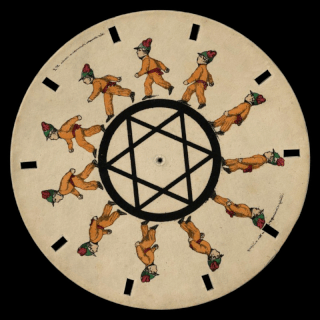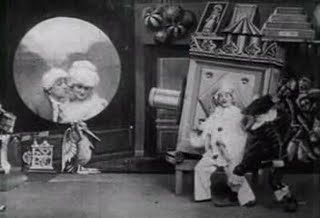Related Research Articles

The magic lantern, also known by its Latin name lanterna magica, is an early type of image projector that used pictures—paintings, prints, or photographs—on transparent plates, one or more lenses, and a light source. It was mostly developed in the 17th century and commonly used for entertainment purposes. It was increasingly used for education during the 19th century. Since the late 19th century, smaller versions were also mass-produced as toys. The magic lantern was in wide use from the 18th century until the mid-20th century when it was superseded by a compact version that could hold many 35 mm photographic slides: the slide projector.

Morphing is a special effect in motion pictures and animations that changes one image or shape into another through a seamless transition. Traditionally such a depiction would be achieved through dissolving techniques on film. Since the early 1990s, this has been replaced by computer software to create more realistic transitions. A similar method is applied to audio recordings in similar fashion, for example, by changing voices or vocal lines.
A stereopticon is a slide projector or relatively powerful "magic lantern", which has two lenses, usually one above the other, and has mainly been used to project photographic images. These devices date back to the mid 19th century, and were a popular form of entertainment and education before the advent of moving pictures.

The phénakisticope was the first widespread animation device that created a fluent illusion of motion. Dubbed "Fantascope" and "Stroboscopische Scheiben" by its inventors, it has been known under very many other names until the French product name Phenakisticope became common. The phenakistiscope is regarded as one of the first forms of moving media entertainment that paved the way for the future motion picture and film industry. Like a GIF animation, it can only show a short continuous loop.

A slide show is a presentation of a series of still images on a projection screen or electronic display device, typically in a prearranged sequence. The changes may be automatic and at regular intervals or they may be manually controlled by a presenter or the viewer. Slide shows originally consisted of a series of individual photographic slides projected onto a screen with a slide projector. When referring to the video or computer-based visual equivalent, in which the slides are not individual physical objects, the term is often written as one word, slideshow.

A raree show, peep show or peep box is an exhibition of pictures or objects, viewed through a small hole or magnifying glass. In 17th and 18th century Europe, it was a popular form of entertainment provided by wandering showmen.

Precursors of film are concepts and devices that have much in common with the later art and techniques of cinema.

The Museum of Precinema is a museum in the Palazzo Angeli, Prato della Valle, Padua, Italy, related to the history of precinema, or precursors of film. It was created in 1998 to display the Minici Zotti Collection, in collaboration with the Comune di Padova. It also produces interactive touring exhibitions and makes valuable loans to other prestigious exhibitions such as 'Lanterne magique et film peint' at the Cinémathèque Française in Paris and the Museum of Cinema in Turin.

Samuel Henry Baker (1824–1909) was an English landscape artist. He was a member of the Royal Birmingham Society of Artists (RBSA) and the Royal Society of Painter-Etchers and Engravers (RE). He painted rural landscape scenes in watercolour.

A projector or image projector is an optical device that projects an image onto a surface, commonly a projection screen. Most projectors create an image by shining a light through a small transparent lens, but some newer types of projectors can project the image directly, by using lasers. A virtual retinal display, or retinal projector, is a projector that projects an image directly on the retina instead of using an external projection screen.
George R. Tweedie was a businessman who gained fame in 1891 by running a popular magic lantern show, titled "Gossip about Ghosts". The show, which cost sixpence, consisted of fifty slides, each illustrating a story about ghosts or supernatural occurrences. One concerned George Villiers, 1st Duke of Buckingham, who supposedly appeared as a ghost to a king's officer to prevent the death of his son. Another touched upon the Legend of Hamilton Tighe, a murdered man who haunted his murderers in headless form.

Owen Graystone Bird was a British professional photographer, active during the late nineteenth and early twentieth centuries. Some sources give his first name as William instead of Owen, however, all sources agree on the prominent use of Graystone. The cause of confusion about the correct form of Bird's full name is unclear, but it does not seem to be a case of multiple photographers using the names "Graystone" and "Bird" in combination, contemporaneously.
Elias Childe (1778–1849) was a British landscape painter. He was a prolific artist, working both in oils and watercolours.
Henry Langdon Childe (1781–1874) was an English showman, known as a developer of the magic lantern and dissolving views, a precursor of the dissolve in cinematic technique. While the priority question on the technical innovations Childe used is still debated, he established the use of double and triple lanterns for special theatrical effects, to the extent that the equipment involved became generally available through suppliers to other professionals. By the 1840s the "dissolving view", rooted in Gothic horror, had become a staple of illustrated talks with restrained animations.
James Warren Childe was an English miniature painter.

Dissolving views were a popular type of 19th century magic lantern show exhibiting the gradual transition from one projected image to another. The effect is similar to a dissolve in modern filmmaking. Typical examples had landscapes that dissolved from day to night or from summer to winter. The effect was achieved by aligning the projection of two matching images and slowly diminishing the first image while introducing the second image. The subject and the effect of magic lantern dissolving views is similar to the popular Diorama theatre paintings which originated in Paris in 1822. The terms "dissolving views", "dioramic views", or simply "diorama" were often used interchangeably in 19th century magic lantern playbills.
Chinese fireworks or paper fireworks, also known by the more distinct French terms feux pyriques or feux arabesques, is a type of optical toy box that displays pictures with twinkling light effects. The pictures are partly printed or painted and partly perforated into plates that are made of paper, parchment or cardboard. Different plates can be placed in the front of the box, one by one. A wheel with a spiraling pattern on coloured transparent paper is made to rotate between a light source and the picture plates, causing the light to flicker and move in different colours through the perforations in the plates.

La Lanterne magique, sold in the United States as The Magic Lantern and in Britain as The Magic Lantern, or the Bioscope in the Toy Shop, is a 1903 French short silent film by Georges Méliès. It was sold by Méliès's Star Film Company and is numbered 520–524 in its catalogues.
Le Bourreau turc, sold in the United States as The Terrible Turkish Executioner, or It Served Him Right and in Britain as What Befell the Turkish Executioner, is a 1903 French short silent film by Georges Méliès. It was sold by Méliès's Star Film Company and is numbered 534–535 in its catalogues.
References
- ↑ "Luikerwaal - Mechanical Slides". www.luikerwaal.com.
- ↑ "Chromatropes". www.luikerwaal.com.
- ↑ "A rare and large Henry Langdon Childe Mahogany-Mounted and Brass Hand-Painted Chromatrope, pair o". www.the-saleroom.com.
- ↑ Balzer, Richard. "Dick Balzer's Website: Homepage". www.dickbalzer.com.
- ↑ The Athenæum. 21 December 1844.
- ↑ "The Royal Polytechnic Institution ... Catalogue for 1841. New edition". 29 September 1845 – via Google Books.